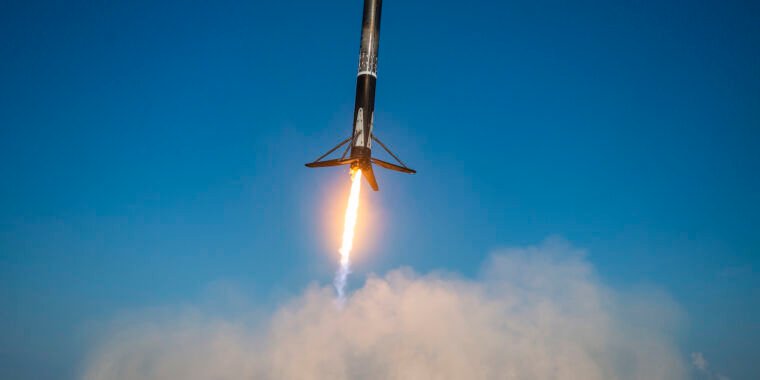Welcome to Edition 7.07 of the Rocket Report! SpaceX has not missed a beat since the Federal Aviation Administration gave the company a green light to resume Falcon 9 launches after a failure last month. In 19 days, SpaceX has launched 10 flights of the Falcon 9 rocket, taking advantage of all three of its Falcon 9 launch pads. This is a remarkable cadence in its own right, but even though it’s a small sample size, it is especially impressive right out of the gate after the rocket’s grounding.
As always, we welcome reader submissions. If you don’t want to miss an issue, please subscribe using the box below (the form will not appear on AMP-enabled versions of the site). Each report will include information on small-, medium-, and heavy-lift rockets as well as a quick look ahead at the next three launches on the calendar.
A quick turnaround for Rocket Lab. Rocket Lab launched its 52nd Electron rocket on August 11 from its private spaceport on Mahia Peninsula in New Zealand, Space News reports. The company’s light-class Electron rocket deployed a small radar imaging satellite into a mid-inclination orbit for Capella Space. This was the shortest turnaround between two Rocket Lab missions from its primary launch base in New Zealand, coming less than nine days after an Electron rocket took off from the same pad with a radar imaging satellite for the Japanese company Synspective. Capella’s Acadia 3 satellite was originally supposed to launch in July, but Capella requested a delay to perform more testing of its spacecraft. Rocket Lab swapped its place in the Electron launch sequence and launched the Synspective mission first.
Now, silence at the launch pad … Rocket Lab hailed the swap as an example of the flexibility provided by Electron, as well as the ability to deliver payloads to specific orbits that are not feasible with rideshare missions, according to Space News. For this tailored launch service, Rocket Lab charges a premium launch price over the price of launching a small payload on a SpaceX rideshare mission. However, SpaceX’s rideshare launches gobble up the lion’s share of small satellites within Rocket Lab’s addressable market. On Friday, a Falcon 9 rocket is slated to launch 116 small payloads into polar orbit. Rocket Lab, meanwhile, projects just one more launch before the end of September and expects to perform 15 to 18 Electron launches this year, a record for the company but well short of the 22 it forecasted earlier in the year. Rocket Lab says customer readiness is the reason it will be far short of projections.
Defense contractors teaming up on solid rockets. Lockheed Martin and General Dynamics are joining forces to kickstart solid rocket motor production, announcing a strategic teaming agreement today that could see new motors roll off the line as early as 2025, Breaking Defense reports. The new agreement could position a third vendor to enter into the ailing solid rocket motor industrial base, which currently only includes L3Harris subsidiary Aerojet Rocketdyne and Northrop Grumman in the United States. Both companies have struggled to meet demands from weapons makers like Lockheed and RTX, which are in desperate need of solid rocket motors for products such as Javelin or the PAC-3 missiles used by the Patriot missile defense system.
Pressure from startups … Demand for solid rocket motors has skyrocketed since Russia’s invasion of Ukraine as the United States and its partners sought to backfill stocks of weapons like Javelin and Stinger, as well as provide motors to meet growing needs in the space domain. Although General Dynamics has kept its interest in the solid rocket motor market quiet until now, several defense tech startups such as Ursa Major Technologies, Anduril, and X-Bow Systems have announced plans to enter the market. (submitted by Ken the Bin)
Going polar with crew. SpaceX will fly the first human spaceflight over the Earth’s poles, possibly before the end of this year, Ars reports. The private Crew Dragon mission will be led by a Chinese-born cryptocurrency entrepreneur named Chun Wang, and he will be joined by a polar explorer, a roboticist, and a filmmaker whom he has befriended in recent years. The “Fram2” mission, named after the Norwegian research ship Fram, will launch into a polar corridor from SpaceX’s launch facilities in Florida and fly directly over the north and south poles. The three- to five-day mission is being timed to fly over Antarctica near the summer solstice in the Southern Hemisphere, to afford maximum lighting.
Wang’s inclination is Wang’s prerogative … Wang told Ars he wanted to try something new, and flying a polar mission aligned with his interests in cold places on Earth. He’s paying the way on a commercial basis, and SpaceX in recent years has demonstrated it can launch satellites into polar orbit from Cape Canaveral, Florida, something no one had done in more than 50 years. The highest-inclination flight ever by a human spacecraft was the Soviet Vostok 6 mission in 1963 when Valentina Tereshkova’s spacecraft reached 65.1 degrees. Now, Fram2 will fly repeatedly and directly over the poles.
Source link
